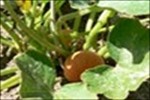
November 01, 2008
In many areas of there is a "nip" in the air. Other areas are still harvesting many fresh vegetables from the garden. No matter where you live, you can still have fresh vegetables from your garden!.
- Continue your vegetable planting.
For the lucky gardeners in the warmer climates you can still be planting kale, collards, lettuce, peas, spinach, turnips, parsnips, cabbage, broccoli, cauliflower, beets, carrots and probably a lot more depending where you are growing. Make sure you take care of your plants by keeping them watered and fertilized. For those of you that live in cooler climates there is still time to plant garlic, shallots and overwintering onions. Keep harvesting what is growing!! - Mulch.
If you are living in a cold or wet climate a heavy layer of straw, leaves and compost will protect your carrots, kale, leeks, Brussel sprouts, broccoli and parsnips. Put in a marker when mulching your vegetables so when it snow or the tops die back you will know where the veggies are. Any kind of marker will do such as a stick, wooden or bamboo stake or metal poles; just make sure they are tall enough in case you get a heavy snow fall. Check my tips for mulching.
- Clean up the garden.
Now is the time to:- build or repair garden structures or trellis
- sharpen and oil tools
- rake leaves for composting or mulch where your brassicas will be next season - they will love it!
- Organize and sort left over seeds.
If you have seeds left over from this summer do not throw them away. For best results fresh seeds should be bought every year, however most seeds can last if stored properly. Learn more about storing seeds . - "
My 2009 Vegetable Garden Journal
"is now available.
It is a simple to follow book that will help you stay organized and give you all the information you need to have a successful vegetable garden.In the book you will find:
- A monthly calender with the best dates to plant.
- Month at a glance to do list to guide you.
- Easy to follow planting, growing and harvesting information for 25 common vegetables.
- Tips on watering, fertilizing, mulching and pest management.
Ready to read more? click here.
VEGETABLE OF THE MONTH  Winter Squash
Winter Squash
Here are my tips for growing great winter squash:
- Squash is planted in late spring as they need warm growing conditions.
- Keep soil moist throughout the season, make sure you water the soil not the leaves.
- Pull weeds when plants are young and mulch with straw.
- Fertilize with compost or manure tea when fruits first start to form.
- By mid summer remove any flowers to focus all the plant's energy for ripening the fruit.
- Harvest before the first frost by cutting the fruit off the plant leaving about 3 inches of stem. Use your fingernail to test if the fruit it ready. Press your nail against the fruit skin and if it leaves a mark it is not ready to be harvested.
- Dry the winter squash in the sun until stems shrivel and turn gray in color. Store in a cool dry area.
For more information on check out growing squash
Keep harvesting and enjoying your fall vegetables. Take the time to can and store for the winter months.
I have several helpful ebooks that will provide you with easy to follow tips to having a fabulous vegetable garden. Check them out.
Please contact me with your comments and suggestions.
If you have enjoyed this ezine please tell a friend.
Welcome to the world of vegetable gardening!
Catherine